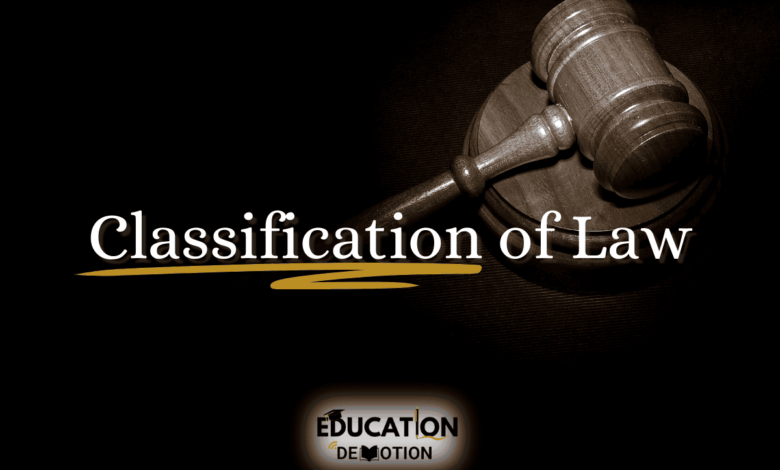
The classification of law refers to organizing laws into distinct categories based on their nature, purpose, and application. By grouping laws systematically, it becomes easier to understand and apply them effectively within a legal framework.
Laws are broadly classified into public and private law, each encompassing further subdivisions. This organization ensures clarity and specialization in legal processes.
Major Categories in the Classification of Law
1. Public Law (Governing State and Society)
Public law regulates the relationship between individuals and the state. It focuses on issues that directly affect society at large. Key branches include:
Constitutional Law
This forms the backbone of a nation’s governance. It defines the roles, powers, and responsibilities of government bodies and ensures citizens’ fundamental rights.
Administrative Law
This law governs public administration. It ensures that governmental actions align with established rules and protects individuals from misuse of authority.
Criminal Law
Criminal law deals with offenses against society. It outlines penalties for crimes such as theft, assault, and murder to maintain social order.
2. Private Law (Managing Individual Relationships)
Private law regulates interactions between individuals or entities without government intervention. Its branches include:
Contract Law
Contract law governs agreements between parties, ensuring that terms are honored and providing remedies for breaches.
Tort Law
This branch addresses civil wrongs, such as negligence, defamation, or nuisance, offering compensation to affected parties.
Property Law
Property law outlines rules regarding ownership, transfer, and use of tangible and intangible assets.
3. International Law (Bridging Nations)
International law governs relations between countries and international organizations. It is divided into:
Public International Law
This focuses on treaties, agreements, and conventions among nations to ensure peaceful coexistence.
Private International Law
Private international law resolves conflicts in cross-border transactions or disputes involving different legal systems.
4. Procedural and Substantive Law
Substantive Law
Substantive law defines the rights and duties of individuals, such as the right to freedom or the obligation to pay taxes.
Procedural Law
Procedural law provides the framework for enforcing substantive laws, detailing steps like filing lawsuits or conducting trials.
5.Criminal and Civil Law (A Fundamental Distinction)
Civil Law
Civil law addresses disputes between individuals or organizations. often resulting in monetary compensation or specific performance.
Criminal Law
Criminal law deals with offenses against the state and imposes punishments like imprisonment or fines to deter unlawful behavior.
Specialized Branches in the Classification of Law
Environmental Law
Environmental law protects natural resources, regulates pollution, and ensures sustainable development for future generations.
Labor Law
Labor law governs employer-employee relationships, covering aspects like wages, working hours, and workplace safety.
Family Law
Family law addresses issues like marriage, divorce, child custody, and inheritance, ensuring fairness in familial disputes.
The Importance of Classifying Law
The classification of law is not merely an academic exercise; it has profound practical implications:
- Clarity: Clear distinctions between types of law simplify legal interpretation and application.
- Specialization: Lawyers and judges can focus on specific areas, enhancing expertise and efficiency.
- Accessibility: Citizens can better understand their rights and responsibilities.
How Classification of Law Impacts Legal Systems
Classifying laws streamlines judicial processes by creating a structured framework. It fosters predictability, allowing individuals and businesses to anticipate legal consequences and operate within the law.
Key Differences Between Public and Private Law
| Aspect | Public Law | Private Law |
|---|---|---|
| Focus | Society and state | Individuals or entities |
| Examples | Constitutional, Criminal | Contract, Tort |
| Nature | Regulatory | Dispute resolution |
Emerging Trends in the Classification of Law
With advancements in technology and globalization, new categories of law have emerged, such as:
Cyber Law
Cyber law addresses issues like data privacy, cybercrimes, and e-commerce regulations in the digital age.
Space Law
Space law governs activities related to outer space exploration, satellite deployment, and resource utilization.
Why Understanding the Classification of Law Matters
Knowledge of the classification of law empowers individuals to navigate legal systems effectively. It also helps policymakers create more targeted and efficient laws to address societal challenges.
See Also; Different Types of Law
Conclusion
The classification of law is a cornerstone of modern legal systems. It organizes the vast body of laws into manageable categories, enabling clarity, specialization, and accessibility. By understanding these classifications, individuals can better appreciate the intricacies of legal systems and their role in shaping society.
FAQs
How is law classified?
Law is classified based on its purpose, scope, and application into categories like public law, private law, and international law.
What is the difference between civil and criminal law?
Civil law resolves disputes between individuals, while criminal law deals with offenses against the state and imposes penalties.
What role does substantive law play?
Substantive law defines individual rights and duties, forming the basis for legal claims and defenses.
Why is procedural law important?
Procedural law provides the framework for enforcing rights and ensures fairness in legal proceedings.
How does environmental law protect society?
Environmental law regulates activities impacting the environment, ensuring sustainable development and resource conservation.
What are the emerging branches of law?
Emerging branches include cyber law, addressing digital issues, and space law, regulating outer space activities.




